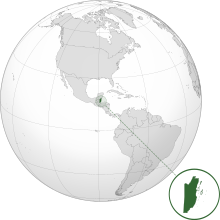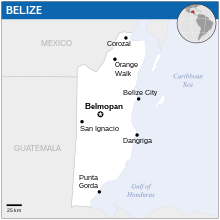
Back Белиз Abkhazian Belize ACE Белиз ADY Belize Afrikaans Belize ALS ቤሊዝ Amharic Belize AMI Belize AN Belīs ANG बेलीज ANP
Belize | |
|---|---|
| Motto: Sub umbra floreo (Latin) "Under the shade I flourish" | |
| Anthem: "Land of the Free" | |
| Capital | Belmopan 17°15′N 88°46′W / 17.250°N 88.767°W |
| Largest city | Belize City 17°29′N 88°11′W / 17.483°N 88.183°W |
| Official languages | English |
| Vernacular language | Belizean Creole |
| Regional and minority languages | |
| Religion (2022)[2] |
|
| Demonym(s) | Belizean |
| Government | Unitary parliamentary constitutional monarchy |
• Monarch | Charles III |
| Froyla Tzalam | |
| Johnny Briceño | |
| Legislature | National Assembly |
| Senate | |
| House of Representatives | |
| Independence from the United Kingdom | |
| January 1964 | |
• Independence | 21 September 1981 |
| Area | |
• Total | 22,966 km2 (8,867 sq mi)[3][4] (147th) |
• Water (%) | 0.8 |
| Population | |
• 2022 census | 397,483[5] |
• Density | 17.31/km2 (44.8/sq mi) |
| GDP (PPP) | 2025 estimate |
• Total | |
• Per capita | |
| GDP (nominal) | 2025 estimate |
• Total | |
• Per capita | |
| Gini (2013) | 53.1[7] high inequality |
| HDI (2022) | high (118th) |
| Currency | Belize dollar ($) (BZD) |
| Time zone | UTC−06:00 (CST) |
| Date format | dd/mm/yyyy (AD) |
| Drives on | Right |
| Calling code | +501 |
| ISO 3166 code | BZ |
| Internet TLD | .bz |
Belize (/bɪˈliːz, bɛ-/ ⓘ, bih-LEEZ, beh-; Belize Kriol English: Bileez) is a country on the north-eastern coast of Central America. It is bordered by Mexico to the north, the Caribbean Sea to the east, and Guatemala to the west and south. It also shares a maritime boundary with Honduras to the southeast. Belize is a member of the Caribbean Community (CARICOM), and is considered part of the Caribbean region and the historical British West Indies.
The Maya civilization spread into the area of Belize between 1500 BC and AD 300 and flourished until about 1200.[9] European contact began in 1502–04 when Christopher Columbus sailed along the Gulf of Honduras.[10] European exploration was begun by English settlers in 1638. Spain and Britain both laid claim to the land until Britain defeated the Spanish in the Battle of St. George's Caye (1798).[11] It became a British colony in 1840, and a Crown colony in 1862. Belize achieved its independence from the United Kingdom on 21 September 1981.[12] It is the only mainland Central American country which is a Commonwealth realm, with King Charles III as its monarch and head of state, represented by a governor-general.[13]
Belize's abundance of terrestrial and marine plants and animals and its diversity of ecosystems, including extensive coral reefs, give it a key place in the globally significant Mesoamerican Biological Corridor.[14] It is considered a Central American and Caribbean nation with strong ties to both the American and Caribbean regions.[15]
It has an area of 22,970 square kilometres (8,867 sq mi) and a population of 397,483 (2022).[16] Its mainland is about 290 km (180 mi) long and 110 km (68 mi) wide. It is the least populated and least densely populated country in Central America. Its population growth rate of 1.87% per year (2018 estimate) is the second-highest in the region and one of the highest in the Western Hemisphere. Its capital is Belmopan, and its largest city is the namesake city of Belize City. The country has a diverse society composed of many cultures and languages. It is the only Central American country where English is the official language, while Spanish is the most widely spoken language. Belizean Creole is the second-most-commonly-spoken dialect, followed by the Mayan languages, Garifuna, and the German dialects. Over half the population is multilingual due to the diverse linguistic backgrounds of the population. It is known for its September Celebrations and punta music.[17][18]
- ^ "Belize Population and Housing Census 2010: Country Report" (PDF). Statistical Institute of Belize. 2013. Archived from the original (PDF) on 13 November 2018. Retrieved 4 January 2019.
- ^ "2022 Population and Housing Census". Retrieved 16 August 2024.
- ^ "Belize § Geography". The World Factbook (2025 ed.). Central Intelligence Agency. 14 August 2019. (Archived 2019 edition.)
- ^ Cite error: The named reference
censusareawas invoked but never defined (see the help page). - ^ "Statistical Institute of Belize Presents Key Findings of the 2022 Population and Housing Census" (PDF). Statistical Institute of Belize. 8 April 2024. Archived (PDF) from the original on 10 April 2024. Retrieved 12 April 2024.
- ^ a b c d "World Economic Outlook Database, October 2024 Edition. (Belize)". IMF.org. International Monetary Fund. 10 October 2024. Retrieved 2 January 2025.
- ^ "Income Gini coefficient". United Nations Development Programme. Archived from the original on 2 July 2015. Retrieved 7 July 2019.
- ^ "Human Development Report 2023/24" (PDF). United Nations Development Programme. 13 March 2024. Retrieved 10 September 2024.
- ^ Cite error: The named reference
cswas invoked but never defined (see the help page). - ^ Byrd Downey, Cristopher (22 May 2012). Stede Bonnet: Charleston's Gentleman Pirate. The History Press. p. 44. ISBN 978-1609495404. Retrieved 25 March 2016.
- ^ Woodard, Colin. "A Blackbeard mystery solved". Republic of Pirates Blog. Archived from the original on 7 April 2016. Retrieved 25 March 2016.
- ^ "Belize | History, Capital, Language, Map, Flag, & Facts | Britannica". www.britannica.com. Archived from the original on 20 September 2023. Retrieved 25 October 2022.
- ^ "Belize – British Honduras – Central America – Nations Online Project". www.nationsonline.org. Archived from the original on 25 October 2022. Retrieved 25 October 2022.
- ^ "Ecosystem Mapping.zip". Archived from the original on 12 May 2011. Retrieved 3 July 2012.
- ^ "CARICOM – Member Country Profile – BELIZE". www.caricom.org. CARICOM. Archived from the original on 18 February 2015. Retrieved 17 February 2015.
- ^ "Postcensal estimates by age group and sex, 2010 – 2022" (XLSX). Statistical Institute of Belize. Archived from the original on 13 December 2022. Retrieved 13 December 2022.
- ^ "Reid between the lines". Belize Times. 27 January 2012. Archived from the original on 10 May 2013.
- ^ Ryan, Jennifer (1995). "The Garifuna and Creole culture of Belize explosion of punta rock". In Will Straw; Stacey Johnson; Rebecca Sullivan; Paul Friedlander; Gary Kennedy (eds.). Popular Music: Style and Identity. Centre for Research on Canadian Cultural Industries and Institutions. pp. 243–248. ISBN 978-0771704598.



